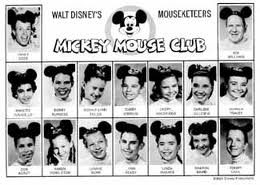 Disney’s Mickey Mouse Club programme was was the first children's club aimed at marketing a proudct and featured Disney characters. Around 550,000 Mickey Mouse hats sold within three months of the programme starting up. Advertisements in Playthings, the toy trade journal, featuring a range of Mickey Mouse and Mousketeer toys, urged toy retailers to “Join the Great Mickey Mouse Buying Parade.” In the 1950s clubs boasted over 1,000,000 members, who were all “potential buyers of Mickey Mouse toys and dolls.”
Disney’s Mickey Mouse Club programme was was the first children's club aimed at marketing a proudct and featured Disney characters. Around 550,000 Mickey Mouse hats sold within three months of the programme starting up. Advertisements in Playthings, the toy trade journal, featuring a range of Mickey Mouse and Mousketeer toys, urged toy retailers to “Join the Great Mickey Mouse Buying Parade.” In the 1950s clubs boasted over 1,000,000 members, who were all “potential buyers of Mickey Mouse toys and dolls.”
Another important aspect of advertising directly to children via the Mickey Mouse Club was that it enabled Disney to advertise to children every week, thereby creating “a year-round consumer demand for toys” at a time when they had only been in strong demand around the Christmas season.
Other children’s clubs, organised by retailers, producers and media outlets, became popular in the 1980s and 1990s and have proliferated in recent times. For example, Geoffrey’s Fun Club, run by  Toys ‘R’ Us, features a cartoon giraffe called Geoffrey from Toys ‘R’ Us advertisements. By 1990 75,000 children had paid their $2.95 a year to join. Burger King Kids Club was established in 1991 and quickly tripled sales.
Toys ‘R’ Us, features a cartoon giraffe called Geoffrey from Toys ‘R’ Us advertisements. By 1990 75,000 children had paid their $2.95 a year to join. Burger King Kids Club was established in 1991 and quickly tripled sales.
Clubs offer an opportunity for marketers to develop a more personal relationship with each child; get information about the children for marketing purposes; and regularly promote products to children by age groups and address. Because children do not recognise clubs as a marketing ploy, they accept advice from the club as genuine, rather than just another advertisement.
Marketing guru James McNeal observes:
On a broad scale, clubs give kids identity—they belong to something. Thus they receive a degree of individuality as well as affiliation. They are elevated in stature by a club. They can refer to their membership just like Dad can his work or Mom hers. They actually possess identifiers—proof of membership and belonging—such as tee-shirts and caps with the club’s logo and they get mail (just like Mom and Dad) with the club’s letterhead on it. Children can meet their need for play as well as their need for affiliation through clubs.
Fortune magazine is a bit more pragmatic about it: “Here’s one formula for building brand loyalty amongst kids. Start a fan club and put a cartoon character with lots of personality in charge. Throw in fun premiums [gifts], make it a mite educational—and you’re set.”